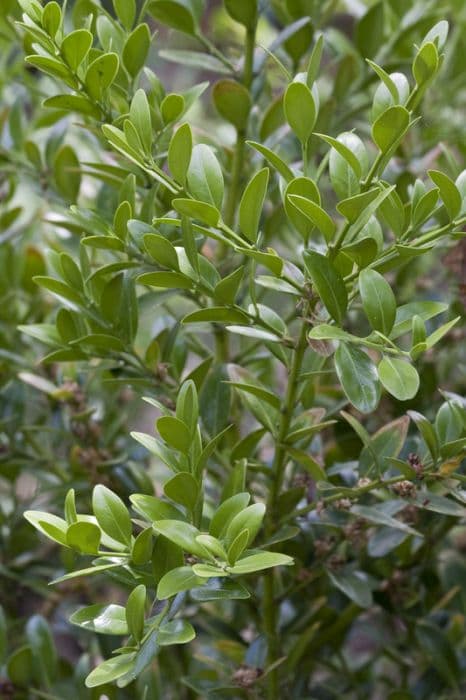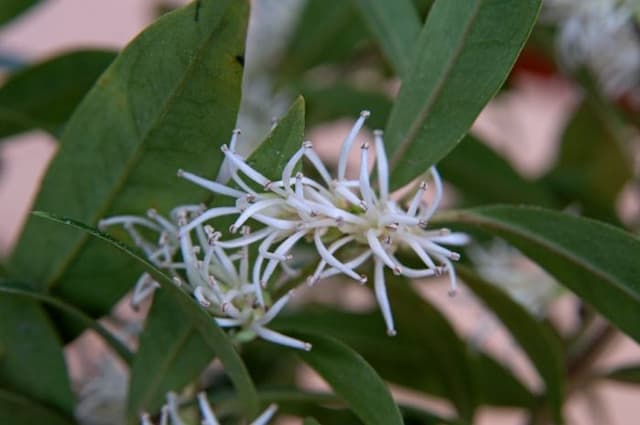Variegated Japanese spurge Pachysandra terminalis 'Variegata' (v)

ABOUT
Pachysandra terminalis 'Variegata', more commonly known as variegated Japanese spurge, is a distinctive, ground-covering plant known for its attractive foliage. The leaves are green with irregular creamy white to pale yellow margins, creating a striking contrast that enlivens shady garden spots. The variegated leaves typically exhibit a glossy sheen and are oval to spear-shaped, often clustered at the end of the stems, lending a lush, dense texture to the plant's overall look. During the early part of the growing season, the Japanese spurge may produce small, inconspicuous flowers that are often overshadowed by the variegated foliage, which remains the standout feature of this cultivar. The overall impression is of a tapestry of light and shade, brought by the variegated leaves which can brighten a low-light garden area with their vibrant pattern.
About this plant
 Names
NamesFamily
Buxaceae.
Synonyms
Variegated Japanese Spurge, Variegated Pachysandra.
Common names
Pachysandra terminalis 'Variegata'.
 Toxicity
ToxicityTo humans
The Japanese Spurge is generally considered to have a low level of toxicity to humans. If ingested, it could possibly cause mild stomach upset but significant toxicity is rare. It is not considered a major toxic threat, but it is always advisable to avoid ingesting parts of ornamental plants due to potential adverse effects.
To pets
The Japanese Spurge is also considered to have low toxicity to pets. However, if pets consume parts of this plant, they may experience mild gastrointestinal upset, such as vomiting or diarrhea. As a precaution, keep an eye on pets and prevent them from eating ornamental plants. Serious complications from consuming Japanese Spurge are unusual, but it is best to be cautious.
 Characteristics
CharacteristicsLife cycle
Perennials
Foliage type
Evergreen
Color of leaves
Variegated
Flower color
White
Height
6-10 inches (15-25 cm)
Spread
12 inches (30 cm)
Plant type
Shrub
Hardiness zones
4-9
Native area
Japan
Benefits
 General Benefits
General Benefits- Ground cover - Pachysandra terminalis 'Variegata', commonly known as Variegated Japanese Spurge, serves as an excellent ground cover, spreading horizontally to suppress weeds.
- Shade tolerance - It thrives even in shaded areas where other plants might struggle, making it versatile for garden design.
- Low maintenance - Once established, it requires minimal care, making it ideal for gardeners looking for low-effort landscaping options.
- Soil erosion prevention - Its dense growth helps stabilize soil, preventing erosion in sloped areas of a garden or landscape.
- Drought resistance - Though it prefers moist soil, it can tolerate periods of dryness once mature, reducing the need for frequent watering.
- Year-round interest - With its variegated foliage, it provides visual interest throughout the seasons, even in winter when other plants may die back.
- Non-invasive - Unlike some ground covers, Variegated Japanese Spurge grows slowly and is unlikely to invade other parts of the garden.
 Medical Properties
Medical PropertiesThis plant is not used for medical purposes.
 Air-purifying Qualities
Air-purifying QualitiesThis plant is not specifically known for air purifying qualities.
 Other Uses
Other Uses- Pachysandra, also known as Japanese Spurge, can be used in floral arrangements for a touch of lush greenery and interesting texture due to its variegated leaves.
- In terrariums, Japanese Spurge can be a low-maintenance plant choice that thrives in the humid, indirect light environment that terrariums provide.
- Japanese Spurge, with its dense growth, can be used to create intricate garden patterns when planted between stepping stones, offering a living mosaic effect.
- In model landscaping, such as for train sets or architectural models, the small, detailed leaves of Japanese Spurge offer a realistic miniature shrubbery option.
- Japanese Spurge is used in garden borders to contrast against flowering plants, highlighting their colors with its variegated foliage.
- It can be planted on slopes to help with soil erosion control due to its dense mat-forming root system, making it effective for stabilizing the ground.
- In shaded ponds or water gardens, Japanese Spurge can provide edge cover that complements water plants and helps blend the water feature into the surrounding landscape.
- For educational purposes, Japanese Spurge can be used to demonstrate the plant's ability to thrive in shady conditions, making it useful for biology classes and gardening workshops.
- In container gardens, particularly those designed for shade, Japanese Spurge can be a striking filler plant that requires minimal attention.
- As a low ground cover in children's gardens, Japanese Spurge's soft texture and non-invasive habit make it a safe and attractive option for areas where kids play.
Interesting Facts
 Feng Shui
Feng ShuiThe plant Japanese Spurge is not used in Feng Shui practice.
 Zodiac Sign Compitability
Zodiac Sign CompitabilityThe plant Japanese Spurge is not used in astrology practice.
 Plant Symbolism
Plant Symbolism- Shade Tolerance: Variegated Pachysandra symbolizes the ability to thrive in the shadow of others, or in less than ideal conditions, representing resilience and adaptability.
- Persistence: Its evergreen nature signifies endurance and the constant effort to grow, no matter the challenges that may come.
- Humble Ground Cover: Used to cover the ground in gardens, it symbolizes humility and the importance of creating a solid foundation before reaching for lofty heights.
- Protection: Dense growth habit offers protection to the soil and smaller creatures, representing safety and shelter.
- Growth: Although it grows slowly, Pachysandra's eventual spread signifies gradual progress and the rewards of patience.
 Water
WaterVariegated Japanese Spurge should be watered thoroughly when the top inch of soil feels dry to the touch, typically once every week or two, depending on the climate and soil conditions. It's better to water less frequently but deeply, ensuring that the water reaches the root zone. You might need about 1 to 1.5 gallons per square yard for each watering session. During hot, dry spells, watering frequency may increase. Avoid over-watering, as Variegated Japanese Spurge does not like soggy soil.
 Light
LightVariegated Japanese Spurge thrives in partial to full shade. It is best placed in a spot where it receives filtered sunlight or morning sun followed by afternoon shade. This plant can tolerate deep shade, making it suitable for woodland gardens or shaded north-facing areas. Direct hot sun can damage the leaves and fade the variegation, so avoid sunny, exposed sites.
 Temperature
TemperatureVariegated Japanese Spurge prefers temperate climates and is hardy from USDA zones 4 through 9. This plant can tolerate a temperature range from approximately -30 to 85 degrees Fahrenheit. The ideal temperature for this ground cover would be between 50 and 70 degrees Fahrenheit for optimal growth and health.
 Pruning
PruningPruning of Variegated Japanese Spurge is mainly done to remove any damaged or diseased foliage and to maintain a tidy appearance. It is a low-maintenance plant that typically does not require frequent pruning. However, an annual trimming in late winter or early spring before new growth starts can be beneficial to rejuvenate older plantings. Prune sparingly, as excessive cutting can delay the spread of this ground cover.
 Cleaning
CleaningAs needed
 Soil
SoilJapanese Spurge (Variegated Pachysandra) thrives best in a soil mix that consists of rich, loamy, and well-draining soil with a slightly acidic to neutral pH, ideally between 5.5 and 7.0. A mix of two parts garden soil, one part sand, and one part organic compost or peat moss will create an optimal environment for this ground cover plant, ensuring good drainage and the right nutrient balance.
 Repotting
RepottingJapanese Spurge doesn't typically require frequent repotting as it is a ground cover plant. It is best left undisturbed once planted. However, if grown in containers, repotting can be done every 2-3 years to replenish the soil and give the roots fresh space to grow.
 Humidity & Misting
Humidity & MistingJapanese Spurge prefers moderate to high humidity levels but is quite adaptable and tolerant of various conditions. As a terrestrial plant, it can thrive in the natural humidity of outdoor environments and doesn't require specific humidity adjustments when planted in the landscape.
 Suitable locations
Suitable locationsIndoor
Grow in a pot with moist soil and indirect light.
Outdoor
Plant in shade, use rich, moist soil, water regularly.
Hardiness zone
4-9 USDA
 Life cycle
Life cycleThe life of the Variegated Japanese Spurge (Pachysandra terminalis 'Variegata') begins with seed germination, which is relatively rare in cultivation, as the plant is most commonly propagated through division or cuttings. Once the seeds or cuttings take root, the plant enters its vegetative stage, where it grows its characteristic variegated leaves and spreads through underground rhizomes to form a dense ground cover. The plant establishes itself firmly in this stage, which can take several years. As it matures, it develops tiny white flowers in early spring, though they are not very conspicuous and often overshadowed by the foliage. After flowering, it enters a period of continued vegetative growth and spread during the warmer months, with its evergreen leaves remaining through the winter. The plant's lifecycle lacks a distinct dormancy period but may exhibit slower growth during colder months before resuming vigorous spread with the return of favorable conditions.
 Propogation
PropogationPropogation time
Spring-Early Summer
The Pachysandra terminalis 'Variegata', commonly known as Variegated Japanese Spurge, is typically propagated by division or cuttings, with the most popular method being division. This is usually done in early spring or fall when the plant is not actively growing. To propagate by division, the root clumps are carefully lifted from the soil and gently separated into smaller sections. Each division should have at least 2 or 3 stems and a healthy root system. These divisions are then replanted into prepared soil, keeping the crown at the same depth as it was originally and spaced about 6 to 12 inches apart (15 to 30 cm). The soil should be kept moist but not waterlogged to encourage the divisions to root and establish. With proper care, these new plantings will grow to form a dense carpet, maintaining the variegated foliage that makes this ground cover so appealing.







![Sweet box [Winter Gem]](/_next/image?url=https%3A%2F%2Fplants-admin.emdemapps.com%2Fimages%2Fplants%2F%2Fimages%2F604b6267b442c.png&w=640&q=75)

